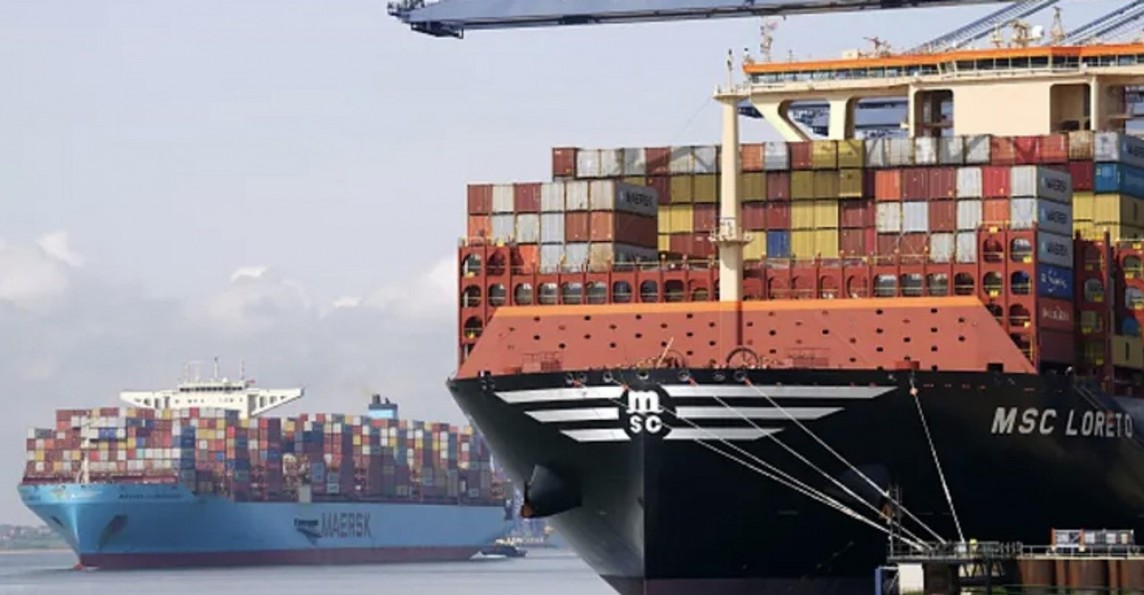| Why are shipping rates skyrocketing? Shipping rates hit record highs amid Red Sea crisis |
Just as the US Federal Reserve (Fed) and the US economy receive good news on inflation, with consumer and wholesale prices falling slightly, rising freight rates are a new concern in the global supply chain with forecasts warning that freight rates could reach $20,000/40-foot container, possibly even hitting a peak of $30,000 like the Covid period and remaining at that level until 2025.
Spot ocean freight rates from the Far East to the U.S. are up 36%-41% month-over-month, and ocean carriers have increased additional fees known as general rate increases by about 140%, according to supply chain data compiled by CNBC. Those costs have pushed the price of a 40-foot container of goods to about $12,000.
Container shortages and limited overseas vessel capacity have forced shippers to turn to the spot market to find loading and unloading equipment at their origin. Freight is also congested at ports due to long dwell times and a scarcity of empty containers to load cargo.
Sea-Intelligence has issued a forecast note predicting that Asia-Europe spot rates could exceed $20,000 per 40-foot container, due to the crisis in the Red Sea – Houthi rebels have stepped up attacks on ships recently – and the increase in nautical miles travelled needing to be factored in. The pandemic has set a precedent that in times of severe stress, freight rates per nautical mile can reach these very high levels.
According to a Defense Intelligence Agency report on the economic impact of the Houthis' Red Sea attacks, container shipping through the Red Sea fell by about 90% from December 2023 to mid-February of this year.
 |
| Risk of ocean freight rates exceeding $20,000 to impact global trade by 2025 |
The alternative routes around Africa not only add about 11,000 nautical miles (a transit time of one to two weeks) but also add about $1 million in fuel costs to each voyage. Sea-Intelligence data estimates that if freight rates paid per nautical mile were similar to those during the pandemic, spot rates of $18,900 per 40-foot container from Shanghai to Rotterdam, $21,600 per 40-foot container from Shanghai to Genoa, and $21,200 per 40-foot container on the reverse route from Rotterdam to Shanghai would also be possible. On the trans- Pacific (Asia to the US West Coast/East Coast), maximum spot rates would be similar to those during the pandemic, when some rates reached $30,000 per container.
Analysts say the global economy is in a new world of inflationary volatility, even as the latest Fed comments and US CPI data point to progress towards deflation. The spike in ocean freight rates, along with air freight, is a reminder of that. The market is seeing weak demand with container bookings down 48% and abundant supply with vessel capacity up 2.6%, but carriers as a whole are booming with rates up as much as 140%.
Spot air freight rates from China to North America rose 43% year-on-year in May to $4.88 per kilogram, according to transport intelligence firm Xeneta. Global spot air freight rates in May rose 9% year-on-year to $2.58 per kilogram.
Rising demand is a factor in the air cargo market. Xeneta said the global air cargo market is on track for double-digit volume growth by 2024, after demand surged +12% year-on-year in May.
Companies from Apple to Chinese retailers Temu and Shein to semiconductor companies are using air freight as their preferred option for shipping products. If the costs persist through the end of the summer, that would put upward pressure on prices for Apple and its chip products that are shipped to end users and consumers.
Disruptions to ocean container services will have an impact on air freight. Since 98% of the world’s goods are transported by sea, even a 0.2% change would result in a 10% increase in air freight volumes. This shows how sensitive air freight can be to disruptions at sea.
While global spot rates rose 9% in May from a year earlier, not all major trade routes around the world saw such a rise in spot rates. Trade from Europe to North America fell 21%. Container bookings and shipping orders from shippers to ocean carriers fell 48% month-on-month, according to ocean freight data from Freight Waves.
Shipping lines are canceling sailings and about 37% of ocean bookings, creating a tighter market for containers on ships, driving up container prices. Adding to the limited availability of containers is longer transit times through the Red Sea.
Xeneta data tracking ocean freight rates from the Far East to U.S. East, West, and Gulf Coast ports shows a historical trajectory. First, a significant volume of containers will enter North America on larger vessels and through ports that shippers are unfamiliar with, while a higher total of vessels through traditional gateways will crowd out existing supply chain activity.
Port delays are creating a “pinching” effect similar to the ship arrivals that have led to port congestion during the pandemic. Port congestion continues at key ports in China and Southeast Asia. Singapore has been congested for weeks, with ships waiting an average of seven days to enter port. Waiting times have also increased in all major Chinese port regions, with Shanghai and Qingdao having the longest wait times.
The worsening port congestion has crippled about 2 million tonnes of ship capacity, nearly 7% of the fleet, according to container shipping market intelligence firm Linerlytica. This could create significant challenges for shippers: shipping large volumes of containers into North America earlier in the peak season on larger vessels can create congestion at ports. The entry of smaller vessels adds to congestion at ports.
Source: https://congthuong.vn/nguy-co-gia-cuoc-van-tai-bien-vuot-muc-20000-usd-tac-dong-den-thuong-mai-toan-cau-326832.html



![[Photo] Nearly 3,000 students moved by stories about soldiers](https://vphoto.vietnam.vn/thumb/1200x675/vietnam/resource/IMAGE/2025/5/17/21da57c8241e42438b423eaa37215e0e)



![[Photo] Readers line up to visit the photo exhibition and receive a special publication commemorating the 135th birthday of President Ho Chi Minh at Nhan Dan Newspaper](https://vphoto.vietnam.vn/thumb/1200x675/vietnam/resource/IMAGE/2025/5/17/85b3197fc6bd43e6a9ee4db15101005b)


































































































Comment (0)